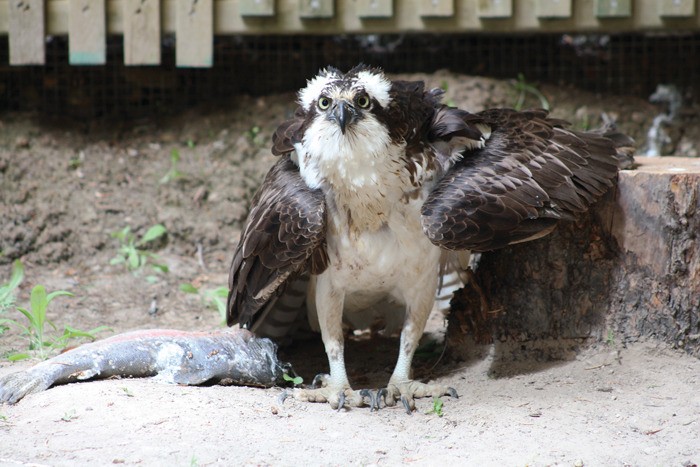The Columbia Valley’s flight cage has been open for about a month now, and thanks to its current inhabitant, it’s almost time to celebrate its first real success story.
Since last summer, hundreds of volunteer hours and thousands of dollars of materials have been used to build what essentially boils down to a rehabilitation facility for larger injured birds. Completed in May, the new 100-foot long facility allows injured birds the freedom of independent, unassisted flight while recuperating from their injuries, and also acts as a massive time saver for Dr. Mark Zehnder and other volunteers.
Originally, when an injured bird was brought to the Invermere Veterinary Hospital, Zehnder would be forced to take the bird back to his farm for the rehabilitation process. This would involve spending at least one hour a day flying the bird by hand, a process that is not only stressful for the bird, but also habituates the animal to human contact. Zehnder would have to fly the birds via a leather harness and a rope — something the birds are not particularly fond of — so they wouldn’t simply fly away.
“They’re wild animals, so that’s not what they’re keen on,” said Zehnder.
The flight cage’s current resident, an approximately one-year-old osprey, was discovered in mid-May on the beach by the Bayshore Condominiums in Invermere. Zehnder and staff from the Invermere Veterinary Hospital brought the bird back to the clinic, where they discovered it was suffering from multiple puncture wounds, likely from a territorial battle or a battle with an eagle over a fish. After several weeks of healing, the osprey is currently building up its strength by taking short, daily — and most importantly — unassisted flights independent of humans. The cage is maintained entirely by volunteers and thanks to the structure, what was once a time-intensive task now consists of tossing in a fish once a day and occasionally coming in to assess the animal. This also helps the bird retain some of its predatory instinct.
“If the birds are used to people all the time, it defeats one of the purposes — minimizing stress and the habituation,” Zehnder said.
While similar flight cages do exist in other places, Zehnder said their cage is an amalgamation of lots of other concepts. When he and his volunteers were first doing their initial research, they asked similar facilities what they would do if they were able to start from scratch, which led to a large mix of ideas resulting in the current structure.
When it came time to fund and build the project, local support was tremendous, none bigger than a $30,000 donation from the Panorama Foundation. A large number of local contractors also donated their time and much of the material used was donated or bought at special prices from Home Hardware.
The cage is not open to the public because of the habituation issues and can currently house about two or three birds of the same species at any given time. Zehnder estimates his clinic sees about 20 injured birds a year, which are released once it’s determined they are strong enough to fly properly. The current osprey is set to be released in a few weeks time.
“Once we assess that they can fly properly, they’ll just go,” Zehnder said. “Once they get to the release stage, they tend to do pretty well.”
Currently, there is a need for fish at the facility, which is why Zehnder is asking people out fishing this summer to consider the flight cage when they pull in some of the local junk fish. He asks that the fish be frozen before they’re brought to the clinic so they can in turn be fed to the injured birds.
